Samsung Galaxy Note 3 Review
by Brian Klug on October 1, 2013 9:00 AM EST- Posted in
- Smartphones
- Samsung
- Mobile
- Android 4.3
- galaxy note 3
Cellular and WiFi
With the advent of MSM8974 comes the third generation of Qualcomm’s LTE modem, in this case what 8974 brings over the second generation is new Category 4 LTE (up to 150 Mbps on the downlink) over the previous generation’s Category 3 maximum, 3GPP release 10 carrier aggregation, up to 3 carriers of HSPA+ aggregated, and of course the requisite CDMA 1xAdvanced/EVDO, GSM/GPRS/EDGE.
Of course it’s up to each operator and handset maker to make their own decision regarding what features they want implemented via the choice of frontend RF components, and in the case of the Note 3 those insights will really have to wait until someone tears one down. I suspect however that with the Note 3 Samsung marches even closer to a single worldwide SKU or at least fewer SKUs for each region. In the case of the T-Mobile Note 3, there’s disclosure for the banding that I would expect in the FCC documents, Bands 2, 4, 5, and 17 LTE are supported, at minimum, I wouldn’t be surprised to see 7 and 20 also supported in the same hardware. I strongly suspect we’re looking at a situation similar to the SGS4 where there was shared platform and front end between AT&T, T-Mobile, and Canada. I haven’t had time however to go through and look at all the Note 3 variants and their banding, and as usual Samsung doesn’t disclose their band combinations up front.
Without 20 MHz FDD LTE to test on T-Mobile, there’s not much we can really say about Category 4 in the context of the Note 3 review. In other markets with 20 MHz FDD LTE however this will open up additional throughput headroom that some already are up against.
The Note 3 continues to have Samsung’s great ServiceMode option for looking at signal characteristics like RSRP, channel bandwidth, and forcing whatever bands you want. However Samsung did remove the unlock shortcuts that were popularized for the previous Galaxy S series and Notes through the debugging screens and phone control menu. This also happens at the same time Samsung has started region locking devices.
As devices move closer to being truly universal with more LTE bands, I wouldn’t be surprised to see more of this kind of arbitrary locking being used to keep operator verticals in place and protect markets.
I had no issues with the Note 3 in both 5 MHz FDD LTE markets like NYC where I did some of my testing, and my home market in Arizona which is 10 MHz FDD LTE on T-Mobile.
Antenna placement on the Note 3 is pretty pragmatic as well, at least on this variant. One big main antenna for transmit on all the bands supported by the hardware, and a second diversity antenna for LTE and WCDMA.
A big new thing in the Note 3 is the inclusion of a component from Qualcomm’s RF360 portfolio, the QFE1100 envelope power tracker, making it the first device to do so. This reduces overall thermal footprint and power consumption on the RF front end by varying the voltage across the power amplifier (which previously was a fixed DC voltage) to match the waveform of the transmitted signal. The envelope tracker essentially is a power supply with a closed loop between the baseband and the power amplifier, which enables the power amplifier to closely follow the desired transmitted waveform. Envelope trackers help mitigate the power waste that comes with high peak to average power ratio inherent to OFDMA (LTE) by closely matching the power amplifier voltage supply to the output signal. This allows the power amplifier to work much closer to the peak of its power added efficiency (PAE) curve, especially when the input signal envelope is low, by tracking the amplitude of the input signal.
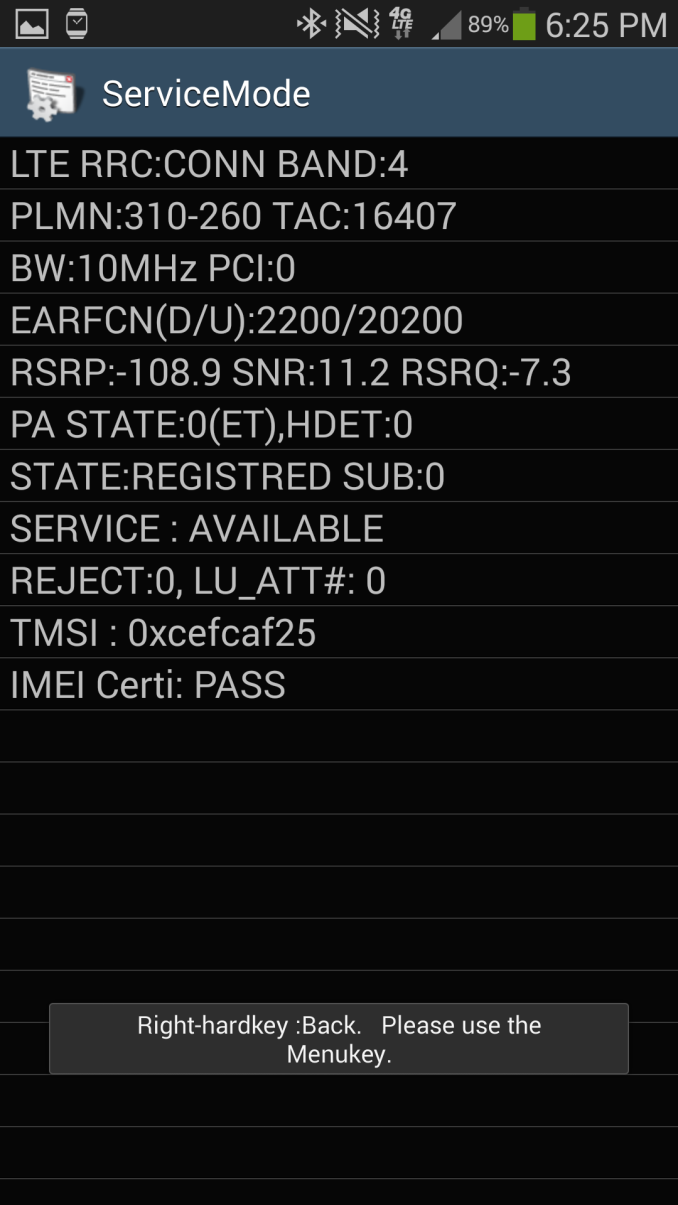
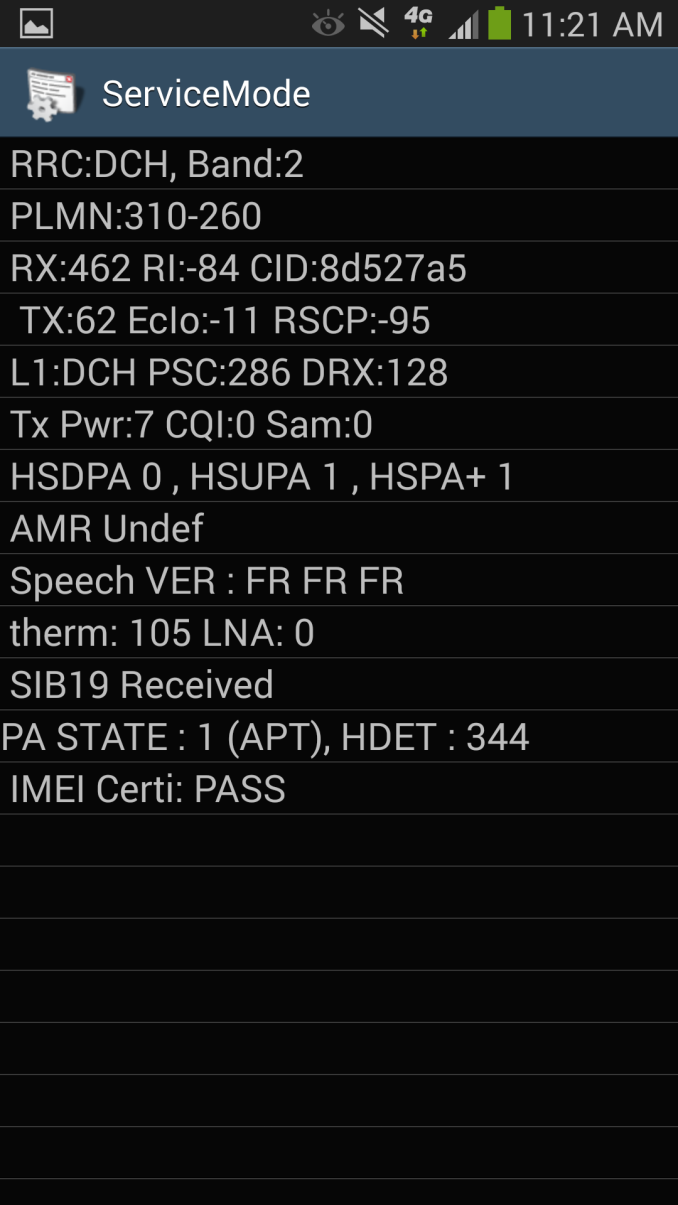
ET (Envelope Tracking), and APT (Average Power Tracking) on Note 3
Watching ServiceMode on the Note 3 is a real treat since you can see PA State change between a few different modes, APT/PT/ET which I suspect translate to average power tracking, power tracking, and envelope tracking modes, again confirming the presence of the power tracker. Qualcomm has a post up about the QFE1100 and its use in the Note 3.
GNSS
With 8974 also comes another newer version of Qualcomm’s GNSS (Global Navigation Satellite System) software suite. The previous generation (GNSS Gen 8/8A) included support for GPS and Russia’s GLONASS system. The new one onboard 8974 and forward moves to GNSS 8B which includes support for GPS, GLONASS, and China’s Beidou constellation.
At present there’s no way for me to validate whether Beidou support is working on any of the 8974 phones I have, because the coverage for that constellation is not global but rather limited to a slice in the Asia-Pacific region. I’m not aware of any other improvements inside GNSS 8B, but Qualcomm’s GNSS has always been excellent for me, locking quickly even indoors or in urban canyon scenarios. The Note 3 performs very well and locks quickly and I don’t have any issues to speak of.
WiFi
I didn’t expect much to change on the Note 3 from SGS4 in terms of WiFi connectivity, but I got an interesting surprise. Instead of the BCM4335 combo which was ubiquitous in this last round for WiFi/BT/FM radio, there’s the newer generation BCM4339 combo which integrates the necessary power amplifiers and front end components for a lower cost solution.
BCM4339 is still a single spatial stream part with support for 802.11a/b/g/n/ac, and on 802.11ac support for up to 80 MHz channels with 256QAM under MCS9, for a PHY rate of 433.3 Mbps, which is what we’ve seen before with 4335. Again what’s new is the integration of the 2.4 and 5 GHz power amplifiers for transmit and low noise amplifiers the receive chain, as well as the other necessary front end components, although handset makers can still choose to support their own external ones. This drives integration cost down and hopefully means 802.11ac will find its way into more places.
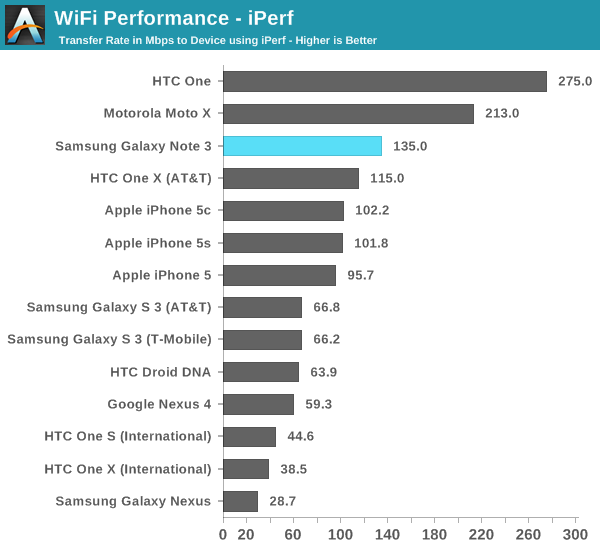
I tested the Note 3 using iPerf the same way I have other phones for a while now and saw some weird behavior. WiFi throughput during my test jumped around quite a bit and even on the 433 Mbps PHY rate the maximum sustained rate I could get was around 135 Mbps. Still very fast, but not quite up as high as some of the other 802.11ac phones I’ve tested.
I don’t like that there’s no band preferences option under the advanced menu anymore, although this seems to be a thing operators want removed (which makes no sense to me, but whatever). The Note 3 does add an auto network switch toggle which seems to be a feature Qualcomm has added to its BSP lately to allow for intelligent switching between WiFi and cellular when the WiFi network you’re attached to isn’t delivering any packets. I also noticed that the Note 3 will shut down the data session for cellular when you’re attached to WiFi as well to cut down on power use, something a few other vendors have done for a while.
Speaker and Noise Rejection
With the Note 3, Samsung changes up the normal speakerphone location dramatically, from the back side coming out of the battery cover to a new place blasting out the bottom lip of the Note 3 through a grille. I tested speakerphone on the Note 3 the same way I have other devices, by placing a call, cranking volume up to maximum, and using a data logging sound pressure meter to record and average the entire call.
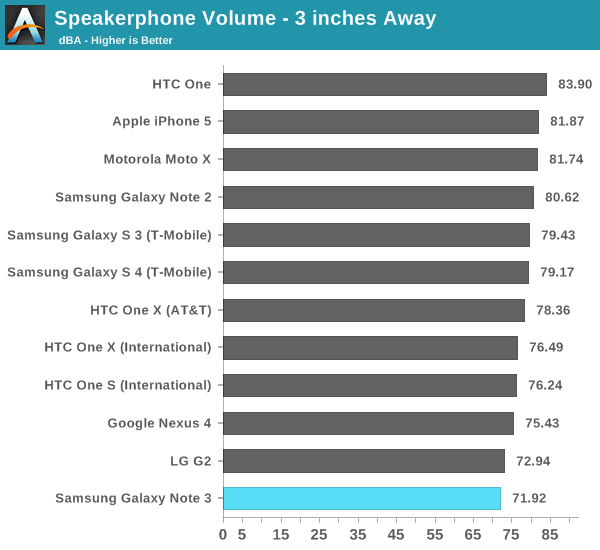
Oddly enough, speakerphone is very quiet on the Note 3 and isn’t nearly as loud as SGS4. More puzzling, tapping the extra volume button doesn’t seem to do anything at all if you’re attached to WiFi, however the button works if you’re not attached to WiFi (and thus the background data connection is enabled). This seems like a bug to me, as it’s very quiet compared to the competition, and unfortunate since part of the Note 3 is that expectation of a great multimedia experience with the big display.
A big change in the Note 3 is the inclusion of a new generation of Audience voice processor, the Audience eS325 which we’ve talked about before, which includes support for using three microphones for ambient noise reduction. Interestingly it turns out the SGS4 had 3 microphones and this same solution, but only ever used them in pairs (the third was next to the earpiece and only used during speakerphone calls). The Note 3 has three very visible microphones, one at top, one at bottom, one on the bottom right side.
Audience enables noise reduction on narrowband (8kHz), wideband(16kHz), and super wideband (24kHz) calls with this new generation with the three microphones. This new solution also adds de-reverb which helps reduce the reflections audible when calling from an enclosed room, something the previous generation didn’t have.
To test I ran through the same test we’ve done in the past, I speak into the handset in front of speakers playing a babble distractor track up to a certain sound pressure level, and then back down. I added in a speakerphone mode (far talk) mode as well just for comparisons, with the noise reduction toggle that Samsung makes available in the phone dialer toggled on and off, for comparisons. I called between a T-Mobile Galaxy S 4 and the Note 3 on T-Mobile, which gave us 12.65 kbps AMR-WB (“HD Voice”) voice call, in a spectogram of the recording we can also see components above the 4 kHz filter for a normal narrowband voice call (narrowband is again 8 kHz sampling, AMR-WB uses 16 kHz sampling, after nyquist we pass 4 kHz and 8 kHz respectively).
The eS325 does a good job rejecting the babble track without rejecting a lot of the incoming voice or making me sound distorted. I’m always impressed that anything is audible at the maximum volumes as these are literally so loud I can’t hear myself talking into the handset and probably not conditions normal people would call under anyways. Noise rejection on these larger phablet or Note sized phones is also a challenge since the microphone pairs are far apart and the mouth is physically further from the microphones than they normally would be, so I’m impressed with overall performance considering those constraints.


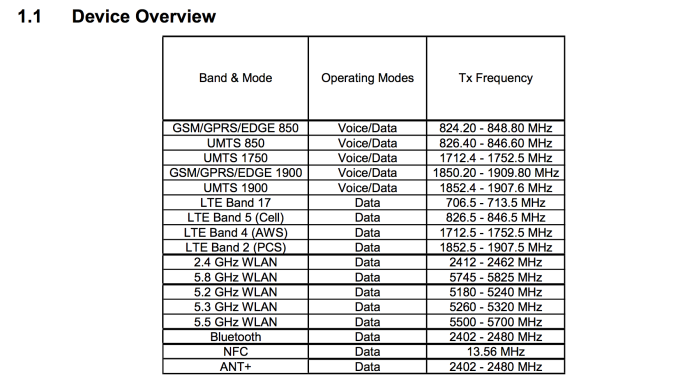
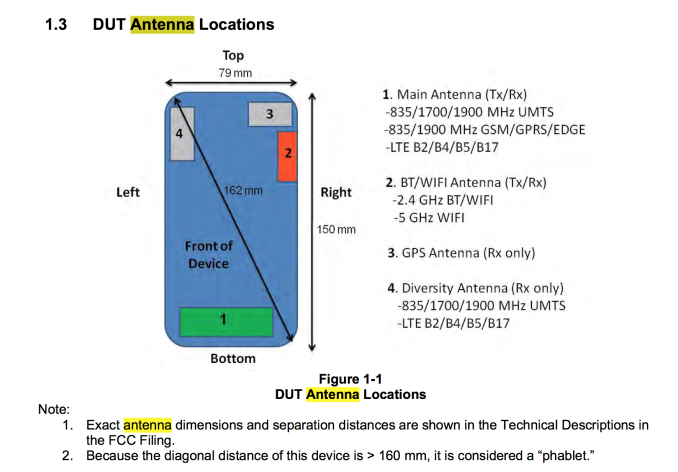
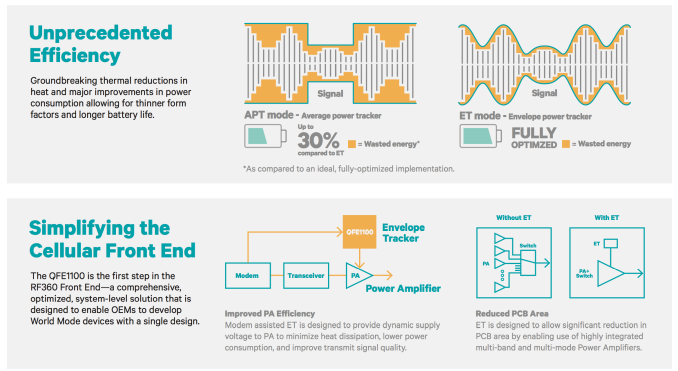
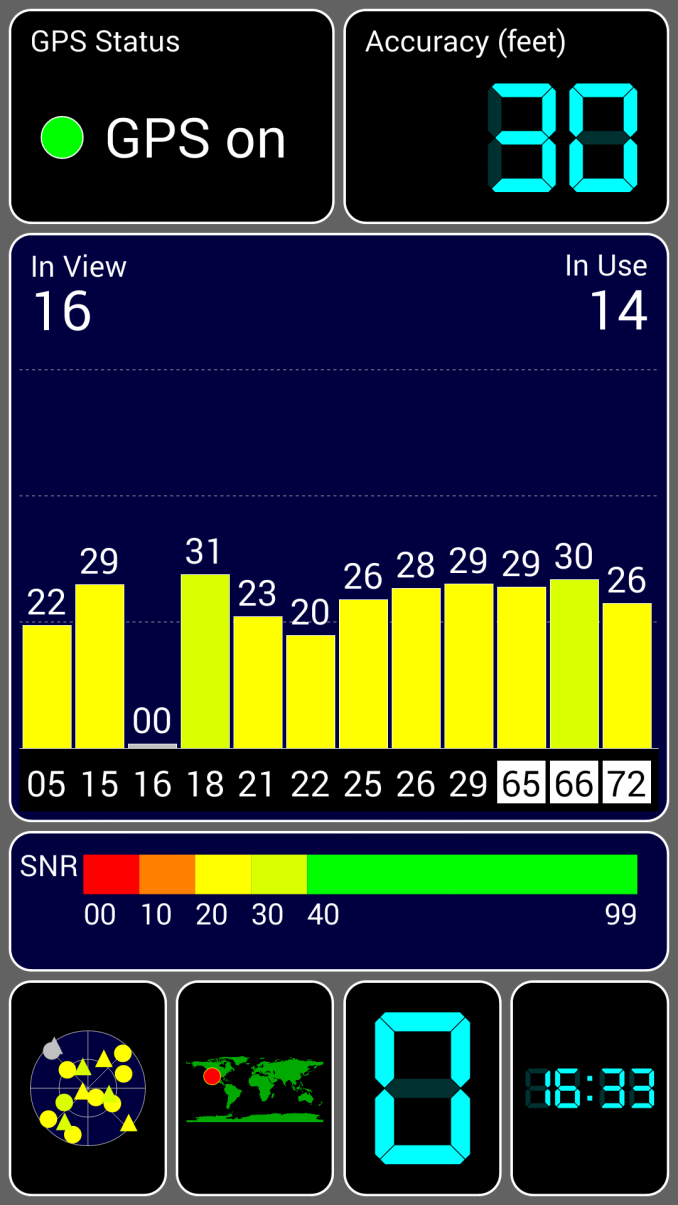
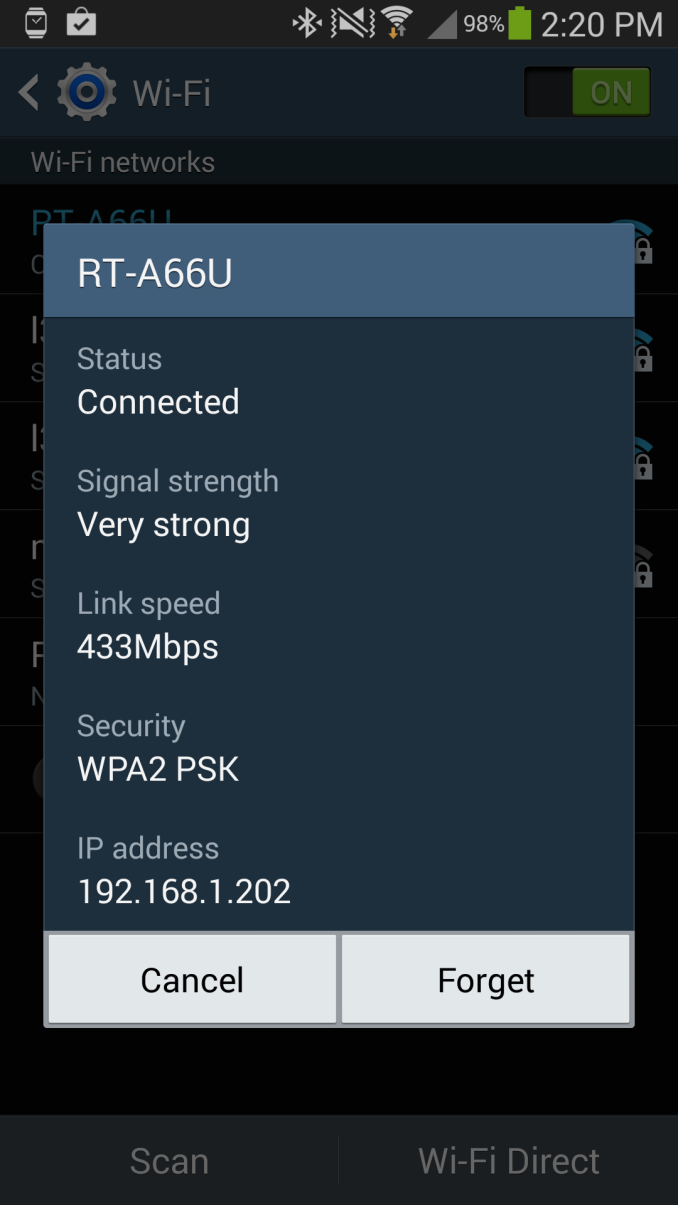
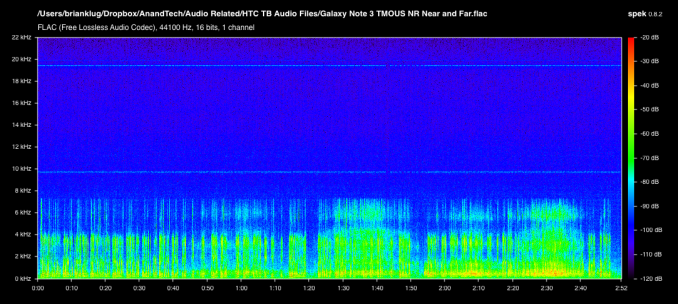








302 Comments
View All Comments
Nathillien - Tuesday, October 1, 2013 - link
You whine too much LOL (as many others posting here).vFunct - Tuesday, October 1, 2013 - link
I agree that it's cheating.The results don't represent real-world use. Benchmarks are supposed to represent real-world use.
Geekbench actually runs real programs, for example.
Che - Tuesday, October 1, 2013 - link
Since when do canned benchmarks really represent real world use?I don't have a dog in this fight, but benchmarks are very controlled, tightly scripted, and only give you details on the one thing they are measuring. The only way to define real world performance is by..... Using said device in the real world for a period of time.
I care more for his comments on the actual use of the phone, this will tell you more than any benchmark.
doobydoo - Saturday, October 19, 2013 - link
They are meant to be a way of measuring the relative performance that you'll get with real world use.Whatever the actual benchmark, provided some element of that benchmark is similar to something you'll do on the device, the relative performance of different phones should give you a reasonable indication how they will relatively perform in real world use.
The problem is when companies specifically enable 'benchmark boosters' to artificially boost the phone above what is normally possible for real world use, and thus the relative scores of the benchmark which were previously useful are not.
darwinosx - Tuesday, October 8, 2013 - link
So you are a kid that owns a Samsung phone. Yes, it really is that obvious.Spunjji - Tuesday, October 8, 2013 - link
Handbag.runner50783 - Tuesday, October 1, 2013 - link
Why is this cheating?, is not that they are swapping CPUs or anything, the SoC is still running under specification, so, get over it.What this make is benchmarks irrelevant, because Manufactures can tweak their kernels to just get better scores that do not reflect daily use.
Chillin1248 - Tuesday, October 1, 2013 - link
No, it is not running under the specification that the consumer will get.They raise the thermal headroom, lock the speed to 2.3 ghz (which would normally kill battery time and cause heat issues). Now if Anand would test the battery life while looping the benchmark tests, then it would be fine as the discrepancy would show up. However, he uses a completely different metric to measure battery life.
Thus, Samsung is able to artificially inflate only their benchmark scores (the only time the "boost" runs is during specific benchmark programs) while hiding said power usage to get those scores.
vFunct - Tuesday, October 1, 2013 - link
It's cheating because the resuts can't be reproduced in the real world for real users.Geekbench uses real-world tests, and they need to represent real use.
Samsung artificially raises the speed of Geekbench so that, for example it's BZip2 compress speeds can't be reproduced when I run BZip2 compress.
Samsung doesn't allow me to run BZip2 as fast as they run it in benchmarks. Samsung gives the benchmarks a cheat to make them run faster than what the regular user would see.
bji - Wednesday, October 2, 2013 - link
You know, you'd think benchmark authors would figure this stuff out and provide a tool to be used with their benchmark to obfuscate the program so that it can't be recognized by cheats like this. Whatever values the cheaters are keying off of when analyzing the program, just make those things totally alterable by the installation tool. If the benchmark program ends up with a randomized name, it is still usable for benchmarking purposes and the cheaters cannot tell its the benchmark they are trying to cheat on.Seriously why do I have to be the one to always think of all of the obvious solutions to these problems!??! Same thing happens at work! lol